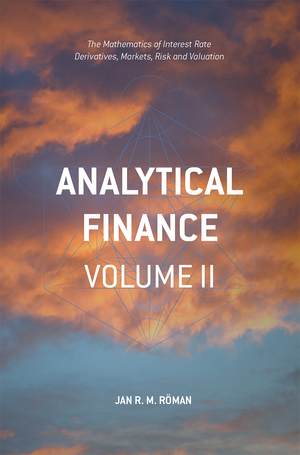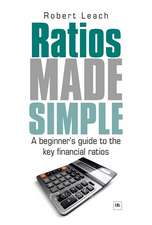Analytical Finance: Volume II: The Mathematics of Interest Rate Derivatives, Markets, Risk and Valuation
Autor Jan R. M. Römanen Limba Engleză Paperback – 13 dec 2017
Coverage includes:
• Date arithmetic’s, quote types of interest rate instruments
• The interbank market and reference rates, including negative rates
• Valuation and modeling of IR instruments; bonds, FRN, FRA, forwards, futures, swaps, CDS, caps/floors and others
• Bootstrapping and how to create interest rate curves from prices of traded instruments
• Risk measures of IR instruments
• Option Adjusted Spread and embedded options
• The term structure equation, martingale measures and stochastic processes of interest rates; Vasicek, Ho-Lee, Hull-While, CIR
• Numerical models; Black-Derman-Toy and forward induction using Arrow-Debreu prices and Newton–Raphson in 2 dimension
• The Heath-Jarrow-Morton framework
• Forward measures and general option pricing models
• Black log-normal and, normal model for derivatives, market models and managing exotics instruments
• Pricing before and after the financial crisis, collateral discounting, multiple curve framework, cheapest-to-deliver curves, CVA, DVA and FVA
| Toate formatele și edițiile | Preț | Express |
|---|---|---|
| Paperback (2) | 506.32 lei 6-8 săpt. | |
| Springer International Publishing – 13 feb 2017 | 506.32 lei 6-8 săpt. | |
| Springer International Publishing – 13 dec 2017 | 602.40 lei 6-8 săpt. |
Preț: 602.40 lei
Preț vechi: 676.85 lei
-11% Nou
Puncte Express: 904
Preț estimativ în valută:
115.28€ • 120.20$ • 95.81£
115.28€ • 120.20$ • 95.81£
Carte tipărită la comandă
Livrare economică 21 martie-04 aprilie
Preluare comenzi: 021 569.72.76
Specificații
ISBN-13: 9783319525839
ISBN-10: 3319525832
Pagini: 310
Ilustrații: XXXI, 728 p. 141 illus.
Dimensiuni: 155 x 235 x 43 mm
Greutate: 1.05 kg
Ediția:1st ed. 2017
Editura: Springer International Publishing
Colecția Palgrave Macmillan
Locul publicării:Cham, Switzerland
ISBN-10: 3319525832
Pagini: 310
Ilustrații: XXXI, 728 p. 141 illus.
Dimensiuni: 155 x 235 x 43 mm
Greutate: 1.05 kg
Ediția:1st ed. 2017
Editura: Springer International Publishing
Colecția Palgrave Macmillan
Locul publicării:Cham, Switzerland
Cuprins
Pricing via Arbitrage.- The Central Limit Theorem.- The Binomial model.- More on Binomial models.- Finite difference methods.- Value-at-Risk – VaR.- Introduction to probability theory.- Stochastic integration.- Partial parabolic differential equations and Feynman-Kač.- The Black-Scholes-Merton model.- American versus European options.- Analytical pricing formulas for American options.- Poisson processes and jump diffusion.- Diffusion models in general.- Hedging.- Exotic Options.- Volatility.- Something about weather derivatives.- A Practical guide to pricing.- Pricing using deflators.- Securities with dividends.- Some Fixed-Income securities and Black-Scholes.
Notă biografică
Jan Roman is Financial Engineer in the Quantitative Risk Modelling Group at Swedbank Robur Funds, where he specializes in risk model validation, focusing on all inputs to front office systems including interest rates and volatility structures. He has over 16 years financial markets experience mostly in financial modeling and valuation in derivatives environments. He has held positions as Head of Market and Credit Risk, Swedbank Markets, Senior Risk Analyst at the Swedish financial Supervisory Authority, Senior Developer at SunGard and Senior Developer, OMX Stockholm Exchange.
Jan is also Senior Lecturer, Malardaran University, Sweden, where he teaches Analytical finance and financial engineering. He holds a PhD in Theoretical Physics from Chalmers University of Technology.
Jan is also Senior Lecturer, Malardaran University, Sweden, where he teaches Analytical finance and financial engineering. He holds a PhD in Theoretical Physics from Chalmers University of Technology.
Textul de pe ultima copertă
Analytical Finance is a comprehensive introduction to the financial engineering of equity and interest rate instruments for financial markets. Developed from notes from the author’s many years in quantitative risk management and modeling roles, and then for the Financial Engineering course at Malardalen University, it provides exhaustive coverage of vanilla and exotic mathematical finance applications for trading and risk management, combining rigorous theory with real market application.
Volume I – Equity Derivatives Markets, Valuation and Risk Management.
Coverage includes:
Volume II – Interest Rate Derivative Markets, Valuation and Risk Management
Coverage includes:
Volume I – Equity Derivatives Markets, Valuation and Risk Management.
Coverage includes:
- The fundamentals of stochastic processes used in finance including the change of measure with Girsanov transformation and the fundamentals of probability throry.
- Discrete time models, such as various binomial models and numerical solutions to Partial Differential Equations (PDEs)
- Monte-Carlosimulations and Value-at-Risk (VaR)
- Continuous time models, such as Black–Scholes-Merton and similar with extensions Arbitrage theory in discrete and continuous time models
Volume II – Interest Rate Derivative Markets, Valuation and Risk Management
Coverage includes:
- Interest Rates including negative interest rates
- Valuation and model most kinds of IR instruments and their definitions.
- Bootstrapping; how to create an interest curve from prices of traded instruments.
- The multi curve framework and collateral discounting
- Difference of bootstrapping for trading and IR Risk
- Models and risk with positive and negative interest rates.
- Risk measures of IR instruments
- Option Adjusted Spread and embedded optionality.
- Pricing theory, calibration and stochastic processes of interest rates
- Numerical methods; Binomial and trinomial trees, PDEs (Crank–Nicholson), Newton–Raphson in 2 dimension.
- Black models, Normal models and Market models
- Pricing before and after the credit crises and the multiple curve framework.
- Valuation with collateral agreements, CVA, DVA and FVA
Caracteristici
Provides a comprehensive introduction to financial instruments in the interest rate markets Includes coverage of standard and exotic instruments Explains how pricing has changed since the financial crisis
Recenzii
“The aim of this book is to cover the most essential elements of valuing derivatives on equity markets. ... The book may be used as a textbook for graduate students in mathematical and analytical finance, and also may be useful for practitioners working in this area of finance.” (Anatoliy Swishchuk, zbMATH 1382.91001, 2018)




















